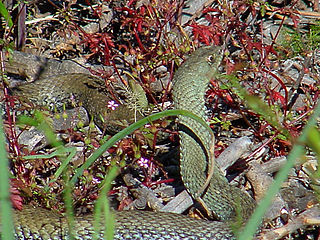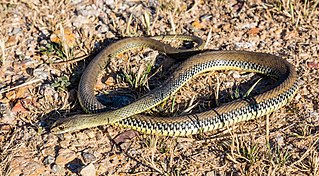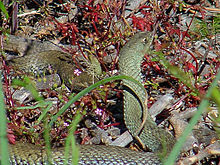
The false cobra, or hooded malpolon, is an opisthoglyphous snake found in parts of Africa and the Middle East. The name "false cobra" comes from the fact that while it is not a cobra, it imitates a cobra's stance by spreading its neck into a hood and hissing like the cobra. It can grow up to 1.5 metres in length and preys on rodents and lizards, while it itself falls prey to the Great grey shrike.

The Aesculapian snake, is a species of nonvenomous snake native to Europe, a member of the Colubrinae subfamily of the family Colubridae. Growing up to 2 metres (6.6 ft) in length, it is among the largest European snakes, similar in size to the four-lined snake and the Montpellier snake. The Aesculapian snake has been of cultural and historical significance for its role in ancient Greek, Roman and Illyrian mythology and derived symbolism.

Psammophiidae is a family of elapoid snakes. They were formerly placed as a subfamily of the Lamprophiidae, but have been more recently identified as a distinct family.

Malpolon monspessulanus, commonly known as the Montpellier snake, is a species of mildly venomous rear-fanged snake.

Calblanque Regional Park, Monte de las Cenizas y Peña del Águila is a regional park in the south-east of Spain, and in this country in the autonomous community Región de Murcia. In this region, it is located in the municipalities Cartagena and La Unión. It is part of Sierra Minera, a mountain chain in the Baetic System.

The eastern Montpellier snake is a species of mildly venomous rear-fanged snake.






